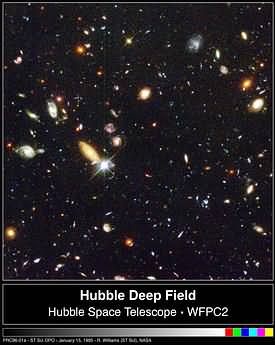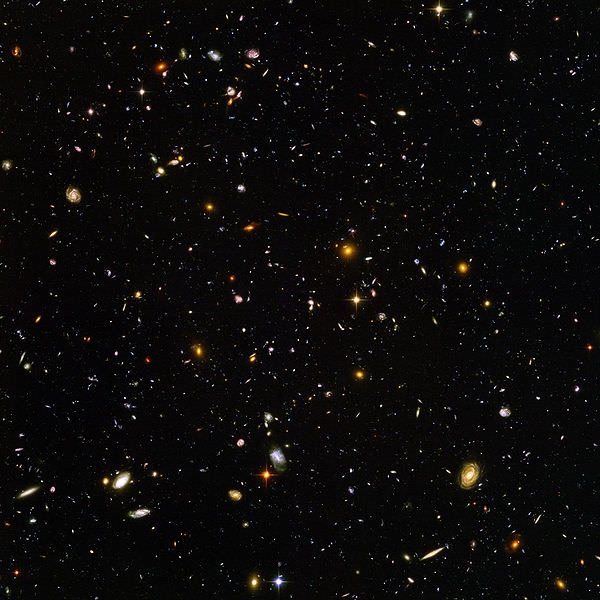[/caption]
Astronomers think that there are hundreds of billions galaxies in the universe, however the exact number is not known. But astronomers should know how many galaxies we’ve actually seen and discovered, right? Well, not necessarily. “We don’t know,” says Ed Churchwell, professor of astronomy at the University of Wisconsin-Madison. “We know it’s a very large number.” In just one image for example, the Hubble Ultra Deep Field, above, there are about 10,000 galaxies visible.
In our own galaxy, There are between 4 billion 100-300 billion stars in the Milky Way. At most, 8,479 of them are visible from Earth. Roughly 2,500 stars are available to the unaided eye in ideal conditions from a single spot at a given time.
But the number of galaxies will keep growing as our telescopes get better and can look out and back farther in time.
“To count them all, you have to be able to look far enough back in time or deep enough in space to see when galaxies were formed,” Churchwell says. “We haven’t reached that point yet. It’s not a well-determined number, but at some point we’re going to reach it.”
The estimate of how many galaxies there are in the universe is done by counting how many galaxies we can see in a small area of the sky. This number is then used to guess how many galaxies there are in the entire sky.
For the time being, the hundreds of billions in the tally are extrapolated from the Hubble Ultra Deep Field, taken over a time period in 2003 and 2004. Pointed at a single piece of space for several months — a spot covering less than one-tenth of one-millionth of the sky — Hubble returned an image of galaxies 13 billion light years away.

“You look at that and say, ‘How many galaxies can I see?’” Churchwell explains. “And that turns out to be a very large number.”
“Then you take that number of galaxies from that postage-stamp-sized piece of the sky and multiply it by the number of postage-stamp-sized pieces of sky,” Churchwell says. “And that turns out to be a much larger number.”
In the first Hubble Deep Field image, taken in 1995, there are about 3,000 galaxies visible in the image.
Source: UW-M


4 billion stars in our galaxy? I thought the current estimate is 100 billion. Is 4 billion the estimate of what we’ve observed?
I know the Milky Way is about 100 billion solar masses, and the number of stars is an estimate with the sun as an average.
Phobos — you are right. The press release said 4 billion, and I’m not sure if that means the estimate of what we’ve observed. Let me check some more and see what info I can find on that. In the meantime, I’ve corrected the number in the article for stars in our galaxy — however I found lots of different numbers, anywhere between 100-300 billion.
I wonder if the estimated number of stars in our galaxy has been adjusted for the recent discovery that the Milky Way was bigger than originally thought.
That’s about 1 million billion billion stars, in the observable universe only.
Numbers have a way of losing all meaning…
These are just galaxies which occur along our past light cone or null projective rays into the past. On the Hubble frame, a coincident frame marked by istropy of galactic motion, there might be an infinite number of galaxies.
LC
LOL! You actually had me thinking there for a minute. Hubble vs Hubble, finite vs infinite. [I’m sure it’s good practice. 8/ ]
10^11 galaxies with 10^11 stars each. That is the rough rule of thumb I learned 😉
DrFlimmer: And I have a nagging suspicion that we’re underestimating the number of galaxies out there, too.
Dr Flimmer, Dave: yes, these were the figures a few years back, so I’d be wrong by a factor of 100, but they’re steadily climbing: it’s now hundredS billions galaxies / stars per galaxy, so I’m getting better, and will not be surprised when it reaches 1000 billions each.
However, the largest uncertainty remains in the ratio observable universe / universe. I would not be surprised if it went far beyond those mere thousands of billions. That is, supposing it’s not infinite (which I think it CAN’T be, but wouldn’t bet!).
🙂
I think it is a tough task to say “there are so and so many galaxies out there with so and so many stars each” – at least, if you want precise numbers.
I say that it will more or a less remain a “guessing game”.
But I am pretty sure that the number of galaxies is not infinite – as far as the preicise definition of “infinite” goes. For an infinite amount of galaxies you would need an infinite amount of matter and therefore an infinite amount of energy. And I think the energy of the big bang was finite.
It is probably almost infinite compared to scales astronomers “normally” deal with. (In which context did I read about the number 10^(10^131)?)
What is the arcmin or arcsec field scale on the HST Deep Field? (Also the South Deep Field & Ultra Deep Field if they’re available.) =Doug B
Jer 33:22 of the historical book from the jews tells us that no one can count the stars.
Galileo (1564–1642) said their was 30,000 stars and when better technology came around there were more and more stars.
Someone said, “The total number of stars in the observable universe is estimated to be 1025 (1 followed by 25 zeros). Nobody knows the actual number.”
That said Jer 33:22 is still correct and it was written between 630 and 580 B.C. That’s over 2,600 years ago!
Well we ever be able to count the stars?
“which I think it CAN’T be, but wouldn’t bet!”
Manu, Dr Flimmer: There is certainly a lot of hints from standard cosmology that the universe is infinite, say the flat geometry.
And I don’t think energy comes into this as a constraint but as the symmetry it is. Both flat geometry and infinite time implies zero energy density (from relativity respectively classical complementarity of energy vs time).
And coincidentally there is IIRC a paper from 2004 where they show that the class of standard cosmology universes (more generally, FRW ones) are exactly zero energy, bypassing the energy criteria problems of GR descriptions.
Yashi, it is exactly the ability to count stars that enables us to claim that they are possibly unbounded in number, that is they are _countably_ infinite.
More to the point, there isn’t a iota of science in such old texts, nor are they correct in general. One must of course check their claims against actual facts. For example, it is known that the hebrew and christian collections are both trivially inconsistent and factually wrong.